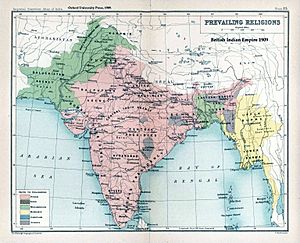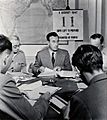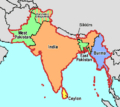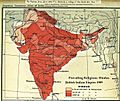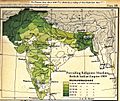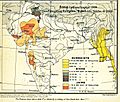Partition of India facts for kids
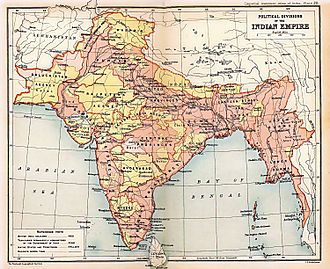
British India in The Imperial Gazetteer of India, 1909. British India is shaded pink, the princely states yellow
|
|
| Date | August 1947 |
|---|---|
| Location | British India |
| Outcome | Partition of British India into independent India and Pakistan and refugee crises |
The Partition of India was a major event in 1947. It divided British India into two new independent countries: India and Pakistan. This split happened as British rule over the Indian subcontinent, known as the British Raj, was ending.
One main reason for the partition was the idea of the Two-nation theory. This idea, supported by Sir Syed Ahmad Khan, suggested that Muslims and Hindus in India were two separate "nations." Because of this, Pakistan was created as a country mainly for Muslims, and India became a country mostly for Hindus. A key leader who supported the partition was Muhammad Ali Jinnah. He became the first leader of Pakistan.
Contents
Why the Partition Happened
End of British Rule
For a long time, India was ruled by the British Empire. After World War II, Britain decided to give India its independence. But there were disagreements about how this new independent country should be formed.
Different Ideas for a New Country
Many people, especially Muslims, worried about their future in a united India. They feared that Hindus, who were the majority, would have too much power. The idea of the Two-nation theory grew stronger. It said that Muslims needed their own separate country to protect their culture and way of life.
Key Leaders and Their Views
Leaders like Muhammad Ali Jinnah strongly pushed for a separate Muslim state. Other leaders, like Mahatma Gandhi and Jawaharlal Nehru, hoped for a united India. However, the differences became too big to solve.
The Big Split
Drawing the Borders
In August 1947, the British drew new borders. These lines divided the land into India and Pakistan. Pakistan was split into two parts: West Pakistan and East Pakistan. East Pakistan later became the country of Bangladesh.
Massive Movement of People
After the borders were set, millions of people had to move. About 14.5 million people crossed the new borders. They moved to the country where their religion was the majority. For example, many Muslims moved to Pakistan. Many Hindus and Sikhs moved to India.
Challenges for New Governments
The new governments of India and Pakistan faced huge challenges. They had to manage this massive movement of people. It was very difficult to provide safety and help for everyone. Sadly, during this time, there was a lot of conflict and many people lost their lives. Estimates suggest that hundreds of thousands, possibly millions, of people died.
Life After Partition
New Beginnings and Difficulties
The Partition of India was a very important and difficult event. It led to the creation of two new nations. But it also caused a lot of pain and hardship for millions of families. Many people lost their homes and loved ones.
Lasting Impact
The partition continues to shape the relationship between India and Pakistan today. It is a reminder of how complex history can be. It also shows the importance of understanding different cultures and working towards peace.
Images for kids
-
British Indian Empire in The Imperial Gazetteer of India, 1909. British India is shaded pink, the princely states yellow.
-
Mohandas Karamchand Gandhi (seated in the carriage, on the right, eyes downcast, with black flat-top hat) receives a big welcome in Karachi in 1916 after his return to India from South Africa
-
Muhammad Ali Jinnah, seated, third from the left, was a supporter of the Lucknow Pact, which, in 1916, ended the three-way rift between the Extremists, the Moderates and the League
-
Jawaharlal Nehru, Sarojini Naidu, Khan Abdul Ghaffar Khan, and Maulana Azad at the 1940 Ramgarh session of the Congress in which Azad was elected president for the second time
-
Chaudhari Khaliquzzaman (left) seconding the 1940 Lahore Resolution of the All-India Muslim League with Jinnah (right) presiding, and Liaquat Ali Khan centre
-
A crowd of Muslims at the Old Fort (Purana Qila) in Delhi, which had been converted into a vast camp for Muslim refugees waiting to be transported to Pakistan. Manchester Guardian, 27 September 1947.
-
Four nations (India, Pakistan, Dominion of Ceylon, and Union of Burma) that gained independence in 1947 and 1948
See also
 In Spanish: Partición de la India para niños
In Spanish: Partición de la India para niños


